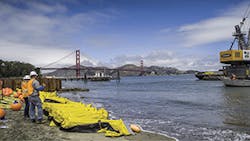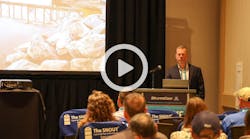This article first appeared in the May 2016 issue of Erosion Control.
Crissy Field
Snowy plovers are dainty little shorebirds, waders that scurry along beaches on legs that look like twigs. The timid plovers have white underbodies with brown feathers on top. The brown markings around their faces give them a quizzical look, somewhat like owls.
The subspecies western snowy plover nests along beaches, estuaries, rivers, and bays all along the coast of the Pacific Ocean during breeding season, which lasts from March until September. The western snowy plover has been listed as a threatened species since 1993.
In the summer of 2015, this tiny shorebird influenced a major flood control project in San Francisco Bay. And the western snowy plover wasn’t the only species that had to be protected during the project.
The project’s designers and workers had to be mindful always of the overall marine environment and its residents: “Birds, seals, sea lions, fish, whales, porpoises, and dolphins,” says Peter Aguilera, project engineer for the Oakland District of the California Department of Transportation (Caltrans).
“We used an air bubble curtain when we were driving piles to lessen the shock waves by 10%, to keep us below [a level] where aquatic animals would be disturbed [by the hydraulic impact and vibration],” says Aguilera. “We had lookouts in boats, watching a 1,300-foot-radius area around the work site. When animals hear the noises they usually flee, but when they were spotted we had to stop working. Then we had to slowly pick up the noise level.”
He adds, “There were so many constraints on this project.”
Six different regulatory agencies had specific requirements for such matters as the amount of shade, the amount of light, noise levels, and other factors. A major ongoing concern was the turbidity levels in the marine environment, so frequent monitoring was a given.
“We took water samples 300 feet downstream every two hours and 100 feet upstream every two hours. We had to be below 10% of the ambient turbidity in the water,” explains Aguilera.
Power Engineering Construction set up a testing lab on Crissy Beach. That close access meant faster results on the quality of the water samples.
“At Caltrans we have a Department of Water Pollution Control. They did a great job. The original proposal was for the turbidity curtain to encompass the entire length of the pipe. Our Water Pollution Control people ran a computer model and discovered that the curtain would fail because of strong currents,” explains Aguilera.
More model testing showed that a revised design would work. The new design called for a shorter curtain that would extend just past where the pipe came out of the ground.
More anchors needed to be added so that the custom-built curtain would be heavy enough to withstand the current. The curtain chosen was Ruffwater Type III, made by Elastec/American Marine of Carmi, IL.
“We picked the toughest heavy-duty one made. Without fail it did a great job. Two reps from Elastec came and stayed during the [curtain’s] installation. That helped the contractor.”
A constraint that put pressure on everyone involved in the project was the tight time frame. That limitation applied to both design and construction phases of the project.
“We had to begin by May 15, and we had to finish by October 31,” says Aguilera.
“The design work that would normally take two years we did in a six-month period. We had two meetings a day and exchanged 20 or 30 e-mails a day during the design phase. There were many iterations of designs to see. We really brainstormed.”
To save time, “The state furnished pipes, couplings, piles—a lot of things the contractor would normally supply—so we had to get approval for them. Then we were liable for the warranty, not the contractor,” says Aguilera.
With time so scarce, it was fortunate that weather was never a problem. Installation took place during “our better weather time,” he says. “Since California has been in a drought for four years, rain was not a factor.”
Another constraint arose from the project’s National Park Service location and concern for the safety of the visitors it attracts. Once a US Army airfield, Crissy Field is part of San Francisco’s historic military district the Presidio (a major tourist attraction) and offers dramatic views of the bay.
Renovation of the Crissy Field outfall into San Francisco Bay
“We were in a highly populated tourist area. We didn’t want to disturb the public,” says Aguilera.
Staging for the project might have caused problems with the marine environment, but the contractor, Power Engineering Construction, decided not to put equipment and materials on an acre of Crissy Field. That decision saved the time and money that would have been needed to replant the field. Instead, the contractor built an elevated platform on the beach. “That reduced our footprint,” says Aguilera.
Timber mats 1 foot thick were also placed on Crissy Beach for parking of construction equipment. They protected the fragile beach vegetation from damage.
The project came about because flooding was occurring in the Mason Street and Crissy Field areas of San Francisco. The aging IJKL sewer drain and IJKL outfall sewer pipe that carried runoff from the neighborhood into San Francisco Bay was too small.
That inadequate capacity was diminished even further because the end of the outfall was too short. It ended at the water’s edge, so that it was often blocked by sand. When the sand blockages occurred, crews had to remove them.
The outfall’s location was within National Park Service land and control. It was also within a Wildlife Protected Area.
Doyle Drive is close to San Francisco’s famous Golden Gate Bridge, where Caltrans had completed a major renovation project. With the Doyle Drive Roadway Improvement Project, “we created more impervious area, so we were responsible for the added runoff ,” says Aguilera.
“Normally we [as a California state agency] don’t do work on federal lands, but 8% more runoff was going down the outfall. There was more flooding because we had done the big bridge project,” explains Aguilera.
Before work began, a bathymetric survey was done “all over the beach and in the water, so we knew the contours of the bottom of the bay,” says Aguilera.
The existing 42-inch HDPE outfall pipe was expanded to 54 inches. It was extended into the San Francisco Bay so that runoff would be discharged into deeper water. Water depth from the bottom of the bay to the mean high water mark is 15.5 feet.
“From the beginning of the project, 176 feet of pipe were replaced under Crissy Beach, then the pipe was extended 389 feet into the Bay,” says Aguilera.
“We weren’t allowed to use coffer dams because they might entrap an animal,” he says, adding that sheet piles were used to shore up the pipe.
“We drove 24 13-inch HDPE piles to support the pipe, with a slight slope down of 0.19%. They are two feet above the bay’s floor,” explains Aguilera.
The new outfall pipe was designed for a 50-year accretion, meaning that it will stay unblocked for at least 50 years. Buried beneath Crissy Beach, the pipe daylights in San Francisco Bay, but can’t be seen even during the mean low water time, with one exception for safety.
“Except for the last two piles, all of them are submerged. The final two were left eight feet above the mean high-water mark. A ‘Danger—Submerged Pipeline’ sign was posted there to warn kayakers and other boaters,” says Aguilera.
The 13-inch HDPE piles, called SeaPile …
To continue reading the full article, which includes additional case studies and in-depth reporting, check out the May edition of Erosion Control. Please click here. You may need to log-in or subscribe to our magazine.


